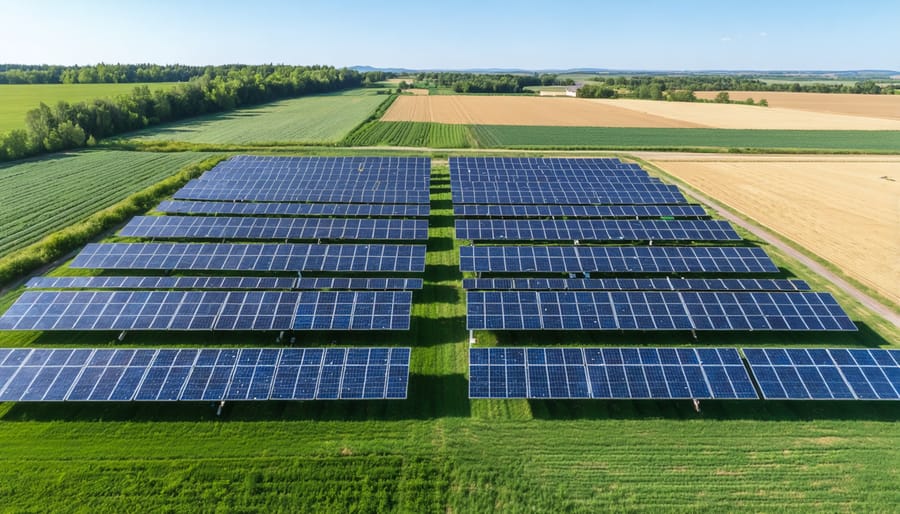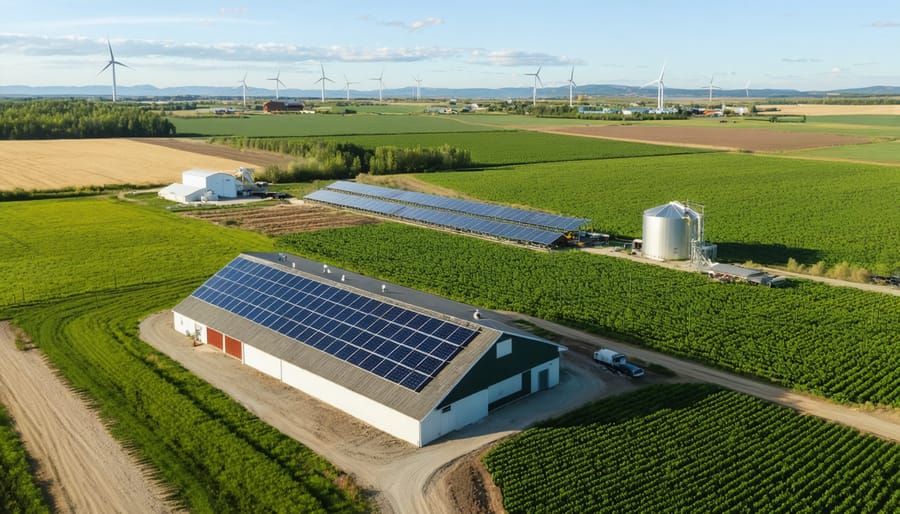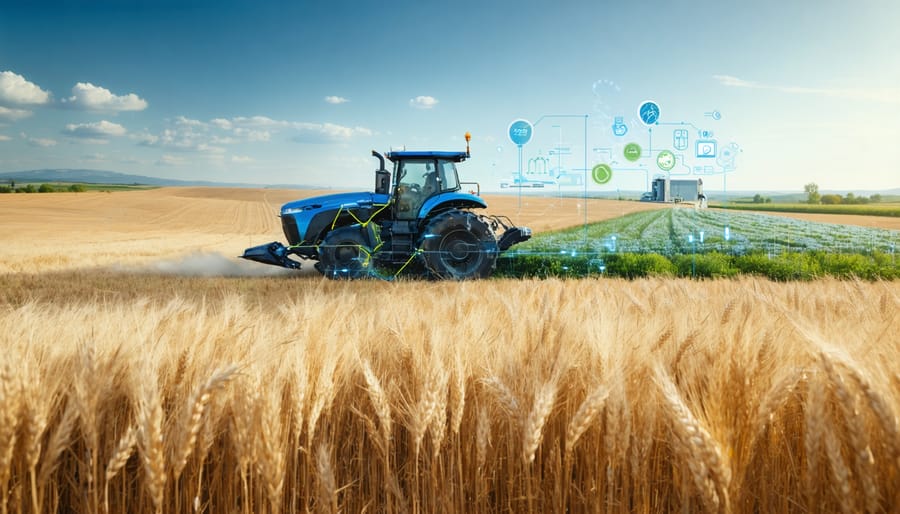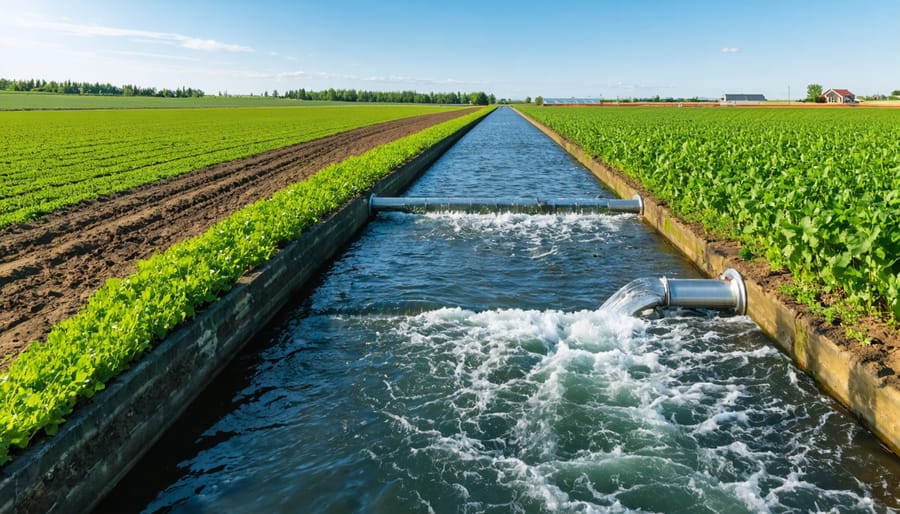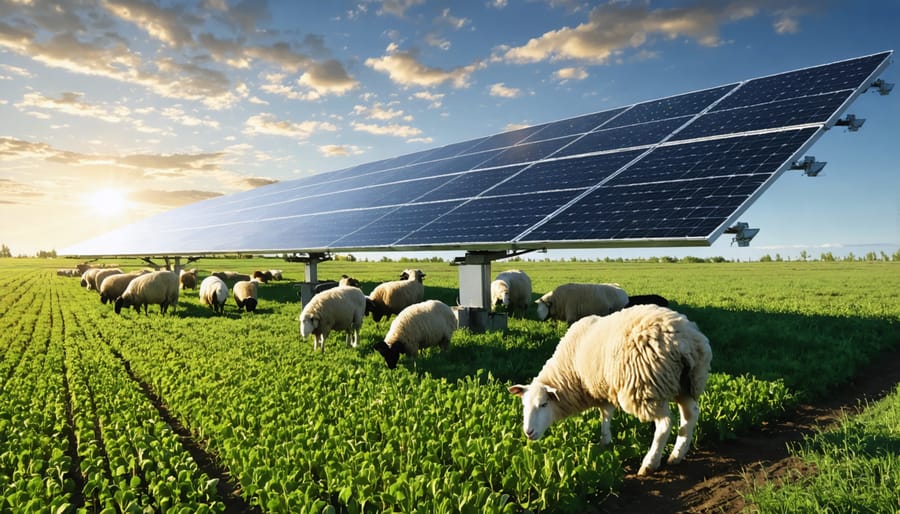In the sun-drenched fields of Alberta, integrated solar applications are revolutionizing modern farming practices, offering a sustainable bridge between traditional agriculture and renewable energy innovation. By seamlessly incorporating solar technologies into existing farm operations, producers are harvesting both crops and clean energy, significantly reducing operational costs while enhancing environmental stewardship.
Canadian farmers are discovering innovative ways to maximize their land use through dual-purpose solar installations – from solar-powered irrigation systems that reduce grid dependency to greenhouse operations enhanced by photovoltaic panels that provide both shade and power. These integrated solutions address two critical challenges: rising energy costs and environmental sustainability.
Recent data from Alberta’s agricultural sector shows that farms implementing integrated solar solutions achieve average energy cost reductions of 60-70%, with some operations becoming completely energy independent during peak summer months. This transformation isn’t just about energy production – it’s about creating resilient, future-proof farming operations that maintain productivity while embracing clean technology.
The integration of solar applications in agriculture represents more than an environmental choice – it’s becoming a crucial business strategy for modern Canadian farmers looking to maintain competitiveness in an evolving agricultural landscape.
Smart Solar Integration for Modern Farms
Dual-Use Solar Systems
Agrivoltaic systems are revolutionizing how we think about land use in Alberta’s agricultural sector. These innovative setups allow farmers to grow crops and generate solar power on the same plot of land, maximizing productivity per hectare. The solar panels are mounted on raised structures, typically 3-4 metres high, creating partially shaded areas underneath where crops can grow.
Many Alberta farmers have found that certain crops actually thrive under these conditions. Shade-tolerant vegetables like lettuce and spinach show improved yields, while some grazing operations report better animal comfort in the partial shade during hot summer months. The panels also help retain soil moisture, reducing irrigation needs by up to 30%.
Doug Thompson, a farmer near Lethbridge, installed an agrivoltaic system over his berry patch in 2021. “We’ve seen consistent berry production, and our energy bills have dropped by 60%,” he shares. “The panels even helped protect our crops from last summer’s intense heatwave.”
The dual-use approach makes solar adoption more financially viable for farmers, offering both energy savings and maintained agricultural productivity. Local agricultural extension offices can provide guidance on compatible crop selection and system design.
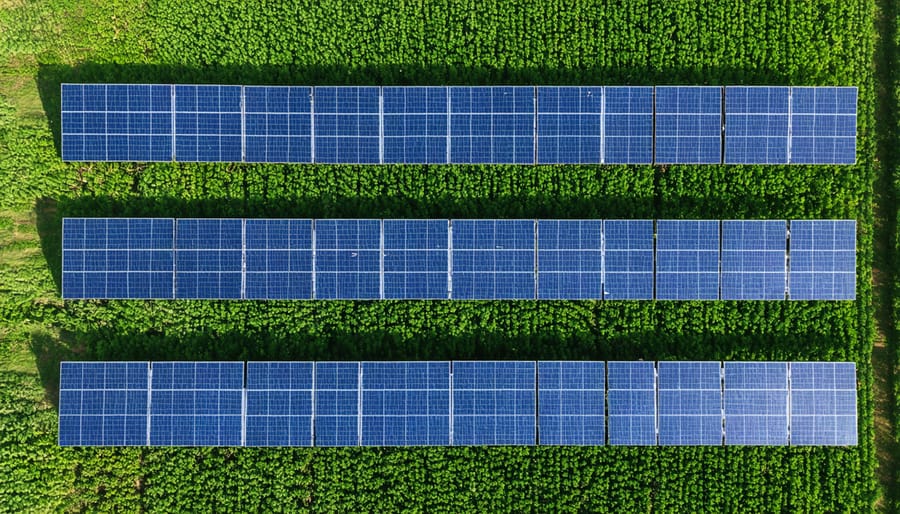
Solar-Powered Farm Equipment
Solar-powered farm equipment is revolutionizing Alberta’s agricultural landscape, offering farmers sustainable alternatives to traditional machinery. From solar-powered irrigation systems to electric fence energizers, these innovations are helping reduce operational costs while maintaining productivity.
Many Alberta farmers have successfully integrated solar-powered water pumps into their operations, which are particularly effective during our summer months when sunlight is abundant. These systems can pump up to 38,000 litres per day, meeting the needs of both crop irrigation and livestock watering.
Portable solar generators are gaining popularity for powering small tools and equipment in remote field locations. These units are especially useful during seeding and harvest seasons, providing clean energy for tablets, sensors, and monitoring equipment.
Solar-powered grain aeration fans are another practical application, helping maintain grain quality while reducing energy costs. Several farms near Lethbridge have reported 40% reductions in electricity expenses after switching to solar-powered aeration systems.
New developments include solar-assisted tractors and autonomous field robots that use photovoltaic panels to extend their operating time. While these technologies are still emerging, early adopters in our farming community are showing promising results in reducing fuel consumption and maintenance costs.
Real Results: Alberta Farm Case Studies
The Morrison Family Farm Transformation
Located just outside of Red Deer, Alberta, the Morrison Family Farm has become a shining example of successful solar integration in dairy farming, joining other proven results in Alberta farms. In 2019, John and Sarah Morrison made the decision to install a 75-kilowatt solar array on their dairy barn roof, transforming their energy-intensive operation into a model of sustainability.
The installation consists of 250 solar panels covering 450 square metres of south-facing roof space. During peak summer months, the system generates enough electricity to power their entire milking operation, including the automated milking system, milk cooling equipment, and ventilation systems. In winter, while production decreases, the system still provides approximately 40% of their energy needs.
The Morrisons report that their monthly electricity bills have decreased by 65% on average, representing annual savings of $12,000. The initial investment of $180,000 was offset by a $60,000 grant from Alberta’s On-Farm Solar Management program, making the project more financially feasible.
Beyond the financial benefits, the Morrisons have noticed improved cow comfort due to the solar panels’ shading effect, which helps maintain more consistent barn temperatures throughout the year. Their success has inspired five neighbouring farms to implement similar systems, creating a growing community of solar-powered dairy operations in central Alberta.
Sustainable Greenhouse Operations
At the Northern Lights Greenhouse in Peace River, Alberta, farmers are revolutionizing cold-climate agriculture through innovative solar integration. This 2-hectare facility demonstrates how solar-powered irrigation systems and climate control can extend growing seasons while reducing operational costs.
The greenhouse utilizes a combination of roof-mounted solar panels and thermal storage systems, maintaining optimal growing conditions even during harsh winter months. Solar thermal collectors heat a glycol-based solution that circulates through underground pipes, providing consistent soil warming. This system has helped reduce heating costs by 60% compared to traditional greenhouse operations.
LED grow lights, powered by the facility’s 75kW solar array, supplement natural light during shorter winter days. The automated climate control system, which manages ventilation, humidity, and temperature, runs entirely on solar power. During summer months, excess energy is stored in battery banks for nighttime operations.
Local farmer Sarah Thompson, who implemented similar systems on a smaller scale, reports year-round production of vegetables and a 40% reduction in energy costs. “The initial investment was offset by government grants and energy savings,” she explains. “We’re now growing tomatoes and cucumbers well into November, something we never thought possible in this climate.”
The success of these operations has inspired a growing network of solar-integrated greenhouses across Alberta, proving that sustainable agriculture can thrive in cold climates while maintaining profitability.
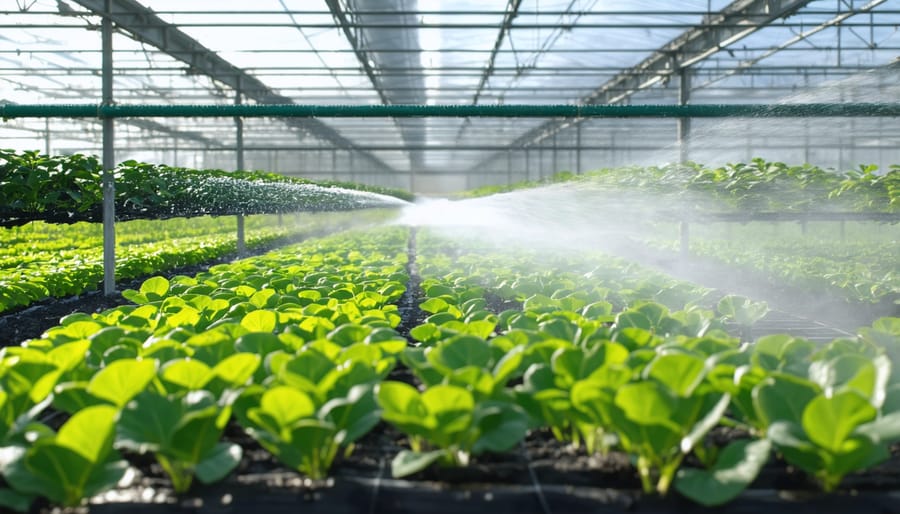
Economic Benefits and Incentives
Government Programs and Rebates
Alberta farmers can currently access several valuable government incentives to support their transition to solar energy. The Canada-Alberta Job Grant covers up to 66% of solar installation training costs, helping farm workers gain necessary skills. Through the Canadian Agricultural Partnership (CAP), farmers can receive funding for up to 50% of their solar project costs, with a maximum of $250,000 per application.
The Municipal Climate Change Action Centre (MCCAC) offers additional rebates through their Alberta Municipal Solar Program, providing $0.75/watt of solar capacity installed. Local utilities may also offer net metering programs, allowing farmers to earn credits for excess energy fed back into the grid.
For organic producers, the Canadian Organic Growers Association provides specialized grants that can be combined with other incentives. The Farm Energy and Agri-Processing Program (FEAP) offers cost-sharing opportunities specifically for energy efficiency upgrades, including solar installations.
Remember that program availability and funding levels may change annually. It’s recommended to consult with local agricultural extension offices or renewable energy consultants to identify current opportunities and optimize your application strategy.
Return on Investment Analysis
The return on investment for solar integration in Alberta farms typically shows promising results within 5-8 years. Initial costs for a standard 10kW system range from $25,000 to $35,000, but federal and provincial incentives can reduce this by up to 40%. Many farmers report annual energy savings between $2,000 and $3,500, depending on system size and usage patterns.
Consider Dave Thompson’s dairy farm near Red Deer, which installed a 15kW system in 2019. His initial investment of $42,000 was offset by $15,000 in grants. The system now generates 90% of his farm’s electricity needs, saving approximately $4,200 annually. Additional benefits include reduced grid dependency and increased property value.
Maintenance costs remain minimal, averaging $200-300 yearly for routine inspections and cleaning. With system lifespans exceeding 25 years and many manufacturers offering 20-year warranties, the long-term financial benefits are substantial. Factor in rising electricity costs, and the case for solar integration becomes even more compelling for Alberta farmers looking to secure their energy future.
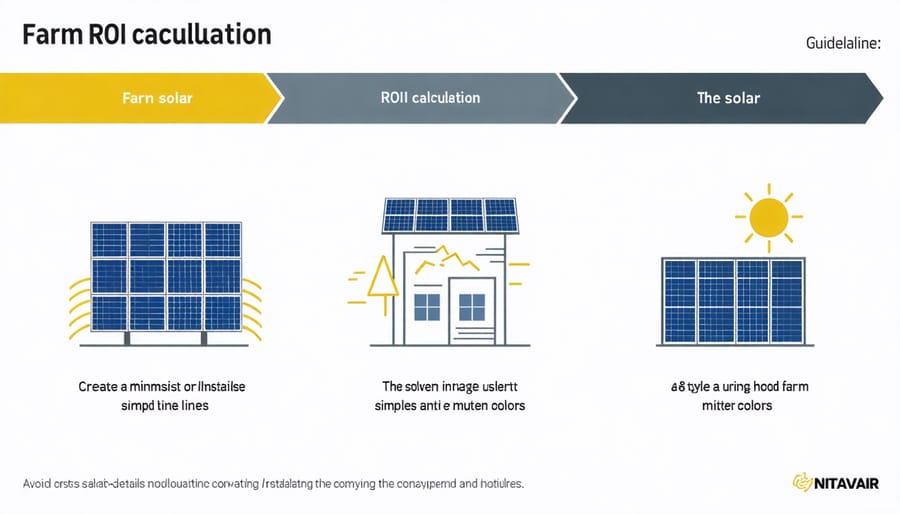
Implementation Guide for Your Farm
Assessment and Planning
Before investing in solar technology, it’s crucial to thoroughly assess your farm’s potential for solar integration. Start by examining your property’s solar exposure, considering factors like annual sunlight hours and seasonal variations. Alberta receives an average of 2,300 hours of sunshine yearly, making it one of Canada’s sunniest provinces.
Begin with a detailed energy audit of your farm operations. Track your monthly energy consumption patterns across different seasons and identify peak usage periods. This information helps determine the optimal size and type of solar system needed. Consider both current needs and potential future expansion of your operations.
Evaluate your available space, including roof areas, ground space, and unused land. South-facing installations typically yield the best results, with a tilt angle of around 40-50 degrees being optimal for Alberta’s latitude. Remember to account for obstacles like trees, buildings, or equipment that might cast shadows.
Contact local solar assessment professionals who understand Alberta’s agricultural context. They can provide detailed site analyses, including 3D modeling of your property and projected energy generation estimates. Many offer free initial consultations and can help identify available grants and incentives.
Don’t forget to review local regulations and permit requirements. Some municipalities have specific guidelines for agricultural solar installations. Also, check with your utility provider about grid connection requirements and net metering options. Early planning and thorough assessment will help ensure your solar investment delivers maximum returns.
Installation and Maintenance
Proper installation and maintenance of integrated solar applications are crucial for long-term success on your farm. Start by conducting a thorough site assessment, considering factors like available roof or ground space, sun exposure, and existing electrical infrastructure. Most Alberta farmers find success working with certified solar installers who understand local building codes and agricultural requirements.
For roof-mounted systems, ensure your building’s structure can support the additional weight, particularly accounting for snow loads common in our prairie winters. Ground-mounted systems require careful placement to avoid shadowing from buildings or equipment while remaining accessible for maintenance.
Regular maintenance is straightforward but essential. Schedule quarterly visual inspections of your panels, looking for dust, debris, or snow accumulation. During our dry seasons, panels typically self-clean with rain, but you might need occasional cleaning using soft water and a gentle brush. In winter, most panels are installed at an angle that allows snow to slide off naturally.
Monitor your system’s performance through its built-in tracking system. Unexpected drops in energy production could indicate issues requiring professional attention. Local solar contractors often offer maintenance packages, which many farmers find valuable for peace of mind.
Remember to keep detailed records of installation, maintenance, and system performance. These records are invaluable for warranty claims and help track your return on investment over time.
The integration of solar applications in Canadian farming represents a significant step forward in sustainable agriculture, offering both environmental and economic benefits that can transform our farming operations. As we’ve seen through numerous success stories across Alberta, farmers who have embraced solar technology are experiencing reduced operational costs, enhanced energy independence, and improved farm efficiency.
By implementing integrated solar solutions, you’re not just investing in your farm’s future; you’re contributing to Canada’s renewable energy goals while maintaining your competitive edge in the agricultural sector. The initial investment is increasingly offset by provincial incentives, reduced energy costs, and the long-term stability that comes with energy independence.
Consider starting small with a single application, such as solar-powered irrigation or grain drying, and gradually expanding as you become more comfortable with the technology. Connect with local agricultural extension services and fellow farmers who have already implemented solar solutions to learn from their experiences and best practices.
Remember, the transition to solar energy isn’t just about environmental stewardship – it’s about building a more resilient and profitable farming operation for future generations. With technology costs continuing to decrease and support systems becoming more accessible, there’s never been a better time to explore solar integration for your farm.
Take the first step today by reaching out to local solar providers or agricultural advisors who can help assess your farm’s solar potential and develop a customized implementation plan that meets your specific needs and goals.


